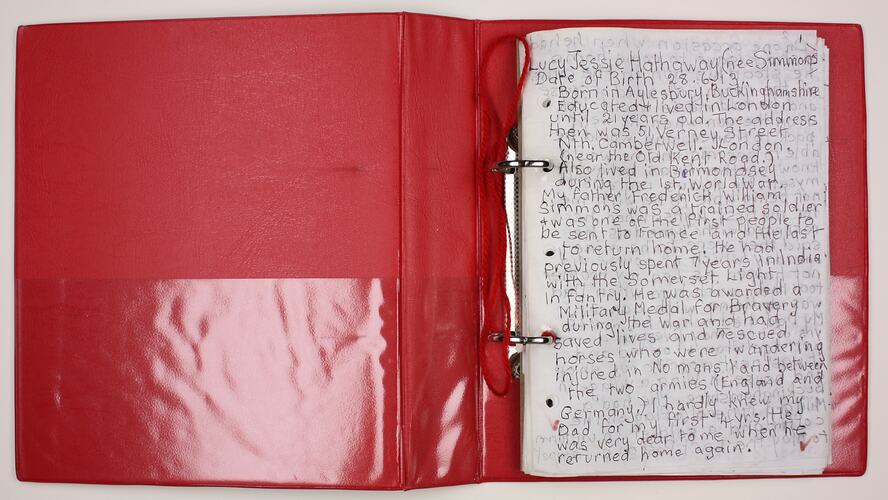Summary
Small ring binder containing 84 loose sheets of paper filled with the handwritten recollections of her life by Lucy Hathaway who migrated to Australia with her husband Stanley and daughters from England in 1951. It was kept at the request of her daughter Merle and nurses at her nursing home to giver her an occupation in 2006. It records her life from childhood until just prior to her death in 2009.
Stanley and Lucy (nee Simmons) Hathaway and their daughter Hazel survived World War II in heavily bombed Coventry, England, remaining there until 1946. They attended the Victory in Europe celebrations there on 8 May 1945. The Hathaways relocated to Buckinghamshire (where second daughter Merle was born in 1948) and Hampshire between 1946 and 1951, finally deciding to migrate to Australia. They applied successfully to the Assisted Passage Migration Scheme but had to wait two years before departing, living and touring England in a caravan until departing on the 'New Australia' 17 November, 1951. They first stayed at the Bathurst Migrant Camp in New South Wales before being relocated to a housing commission estate in Ballarat, Victoria. Within six months they had purchased a block of land, living in a caravan while their house was built. The family became active members of the local Ballarat community, with Lucy working for the newly established McCallum House Centre for Retarded Children at Sebastopol and continued her strong interest in the Brownies and Girl Guides associations.
Physical Description
Red hard cover plastic ring binder folder, A5 size with product details in blue on the spine.Contains 84 loose white lined sheets of paper (12 smaller sized pages) and these are filled with hand written notes in blue and black ink. A piece of red wool is attached to one of the ring binders.
Significance
This collection represents the experiences of thousands of post-war assisted migrants from England who brought with them memories of danger, sadness, courage, austerity and celebration in both tangible and intangible forms. This family survived one of the most severe bombings of any English city during World War II and brought with them material symbols of endurance and triumph in the Victory Day dress and Union Jack flag, symbols with almost universal resonance. The collection also includes items which tell stories about the goods migrants select in order to start new lives, the adventure of the ship voyage, and the seeking of familiar interests in a new community. The collection also explores the theme of maintaining connections and loyalties to homeland, in this case through memorabilia relating to the British monarchy and exchange projects with former local communities.
More Information
-
Collecting Areas
Migration & Cultural Diversity, Public Life & Institutions, Leisure
-
Acquisition Information
Donation from Merle Hathaway, 28 May 2010
-
Author
Mrs Lucy J. Hathaway, Buninyong, Victoria, Australia, 2006-2009
-
Previous Owner
-
Inscriptions
[substantial handwritten text]
-
Classification
-
Category
-
Discipline
-
Type of item
-
Overall Dimensions - Closed
190 mm (Width), 225 mm (Height)
-
Keywords
British Immigration, Institutional Care, Migrant Camps, Migrant Reception Centres, Migration & Settlement




